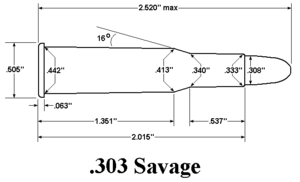.303 Savage: Difference between revisions
m Date maintenance tags and general fixes: build 495: |
|||
| Line 67: | Line 67: | ||
==Non-compatibility with .303 British== |
==Non-compatibility with .303 British== |
||
As with any firearm, it is essential to use the correct type of ammunition. The .303 Savage and the [[.303 British]] cartridge are '''not''' interchangeable with each other. Neither the bullet diameter nor the cartridge dimensions are compatible. Attempting to use .303 Savage ammunition in a firearm chambered for .303 British (or .303 British cartridges in a .303 Savage weapon) is guaranteed to have serious consequences. Such attempts will severely damage the firearm and possibly injure the user. |
As with any firearm, it is essential to use the correct type of ammunition. The .303 Savage and the [[.303 British]] cartridge are '''not''' interchangeable with each other. Neither the bullet diameter nor the cartridge dimensions are compatible. Attempting to use .303 Savage ammunition in a firearm chambered for .303 British (or .303 British cartridges in a .303 Savage weapon) is guaranteed to have serious consequences. Such attempts will severely damage the firearm and possibly injure the user. |
||
In |
In the UK the .303 savage was called the 301 Savage to avoid confusion. |
||
==References== |
==References== |
||
Revision as of 10:53, 22 May 2011
| .303 Savage | ||||||||
|---|---|---|---|---|---|---|---|---|
 .303 Savage cartridge dimensions | ||||||||
| Type | Rifle | |||||||
| Place of origin | ||||||||
| Production history | ||||||||
| Designer | Savage Arms | |||||||
| Manufacturer | Savage Arms | |||||||
| Produced | 1895 | |||||||
| Specifications | ||||||||
| Case type | Rimmed, bottleneck | |||||||
| Bullet diameter | .311 in (7.9 mm) | |||||||
| Neck diameter | .333 in (8.5 mm) | |||||||
| Shoulder diameter | .413 in (10.5 mm) | |||||||
| Base diameter | .442 in (11.2 mm) | |||||||
| Rim diameter | .505 in (12.8 mm) | |||||||
| Rim thickness | .063 in (1.6 mm) | |||||||
| Case length | 2.015 in (51.2 mm) | |||||||
| Primer type | Large rifle | |||||||
| Ballistic performance | ||||||||
| ||||||||
| Source(s): .303 Savage reload data at Hodgdon | ||||||||
The .303 Savage is a rimmed, .30 caliber rifle cartridge developed by the Savage Arms Company in 1894 which was designed as a short action cartridge for their popular Savage Model 99 hammerless lever action rifle. The cartridge was designed for smokeless gunpowder at a time when black-powder cartridges were still popular. The .303 Savage round was ballistically superior to the .30-30 Winchester, but only marginally. The .303 Savage remained popular through the 1930s.[1]
History
Savage Arms created the .303 Savage as part of an unsuccessful attempt at creating a cartridge for the military. Although the cartridge was never popular with the military, it did become a popular round for civilian hunters. Being a pointed-tip rimmed cartridge, it worked well in the Model 99 rifles that Savage produced because of their rotary magazine. However it wasn't as successful in other lever-action rifles because of their tubular magazines. However, the pointed-tip bullets gave it a ballistic advantage over other traditional lever-action cartridges such as the .30-30.[1]
Reloading
The .303 Savage has a small, but loyal fraternity of shooters who reload this cartridge. While major ammunition manufacturers have long since halted production of ammo, dedicated followers can procure loaded ammunition and brass cases through smaller enterprises. The brass cases can be formed from other more popular cases, most notable the .303 British service round. .30-40 Krag brass cases can be formed into .303 Savage dimensions as well.
The .220 Swift cartridge can be made into a passable .303 Savage cartridge, as they are very close in most dimensions, and after forming the .220 Swift is easily cut to proper length.
Non-compatibility with .303 British
As with any firearm, it is essential to use the correct type of ammunition. The .303 Savage and the .303 British cartridge are not interchangeable with each other. Neither the bullet diameter nor the cartridge dimensions are compatible. Attempting to use .303 Savage ammunition in a firearm chambered for .303 British (or .303 British cartridges in a .303 Savage weapon) is guaranteed to have serious consequences. Such attempts will severely damage the firearm and possibly injure the user. In the UK the .303 savage was called the 301 Savage to avoid confusion.
References
This article includes a list of references, related reading, or external links, but its sources remain unclear because it lacks inline citations. (September 2010) |
- Farewell to the Savage 1899 by Holt Bodinson in Guns Magazine Jan 2000
- The Savage Model 99 by Jon Y Wolfe at Chuck Hawks
- Cartridge Dimensions at Steve's Pages
